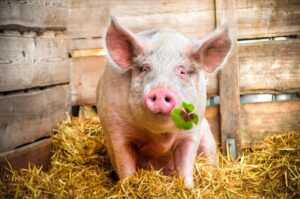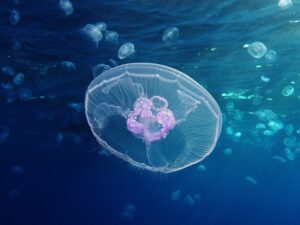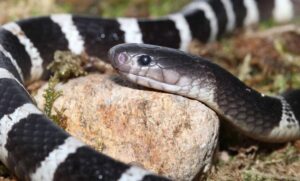If you wanted to choose a unique bird from Africa, some people might immediately think of the fast-running ostrich. In fact, in the swamps of East Africa, there is a very unique and endearing bird: the Shoebill, also known as the shoebill stork. This is considered the Most Dangerous Bird in the World. If you’re curious about this bird, join KnowAllAnimals to explore the details in the following article!
1. The Shoebill: The Most Dangerous Bird in the World with a Unique Beak
- Kingdom: Animalia
- Phylum: Chordata
- Class: Aves
- Order: Pelecaniformes
- Family: Balaenicipitidae
- Genus: Balaeniceps Gould, 1850
- Species: B. rex
The Shoebill primarily lives in the swamps of Africa. It has a majestic and massive appearance, often likened to a dinosaur in the form of a bird.
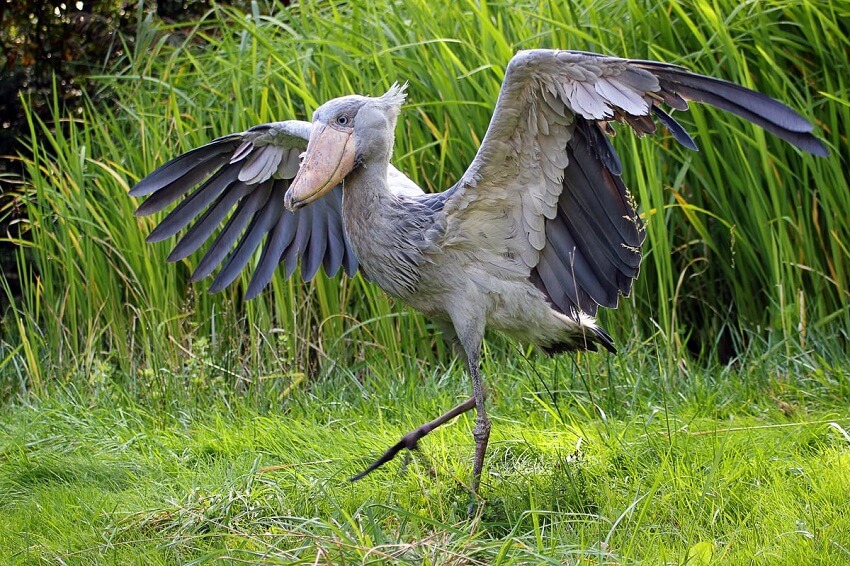
The shoebill is a descendant of the small dinosaur species “Theropoda”—the same group as the T. Rex. Through evolution, its mouth, once full of sharp teeth, was replaced with a beak.
An adult shoebill stands 1.2m (4 ft) tall and can weigh up to 4-7 kg (9-15 lbs). Its wings are very large and broad, with a wingspan of 230-260 cm (7.5-8.5 ft). However, they cannot fly far or too high because their body weight does not allow it.
This bird has extremely long legs, making it an ideal model for many who appreciate beauty. Its large body with such long, thin legs looks a bit “awkward” but creates its own unique charm.
Adult shoebills are usually a pale white color and often stand motionless in the water for an hour or two. This is their unique way of foraging: they hunt by “opening their mouths and waiting for food to fall in.”
Additionally, shoebills are “stars” in many zoos. They often bow to greet tourists, and sometimes even pluck their own feathers and give them to visitors when they are happy.
The most notable feature of the shoebill is its impressively large beak, which is spotted and about 0.12m (4.7 inches) wide. The shoebill’s beak is the widest in the bird kingdom and has many uses, especially for hunting and scooping up water for a drink under the intense African sun.
The front of the wide and sturdy beak is curved into a hook shape. The beak’s special structure is very sharp and can pierce a crocodile’s skin. The edges of the bird’s beak are even as sharp as a razor, easily slicing through its prey’s flesh.
The Dutch also call the shoebill the “father of shoes.” This isn’t because the bird invented or can make shoes, but because their beaks closely resemble the wooden shoes worn by the Dutch.
Shoebills are solitary animals with a lifespan of over 35 years. You will only see this bird in pairs during the dry season, which is their breeding season.

2. The Shoebill: A Natural Predator of Baby Crocodiles
The Shoebill has incredible hunting abilities. Its main diet consists of fish, frogs, and reptiles. Even more remarkably, this bird is a natural predator of crocodiles, especially small ones.
Shoebills often stand motionless in the water with their beaks pressed close to their chests, like a sniper waiting for an enemy to take the bait. The reason their beaks are often lowered and pressed against their chests is that the weight of the beak is quite heavy.
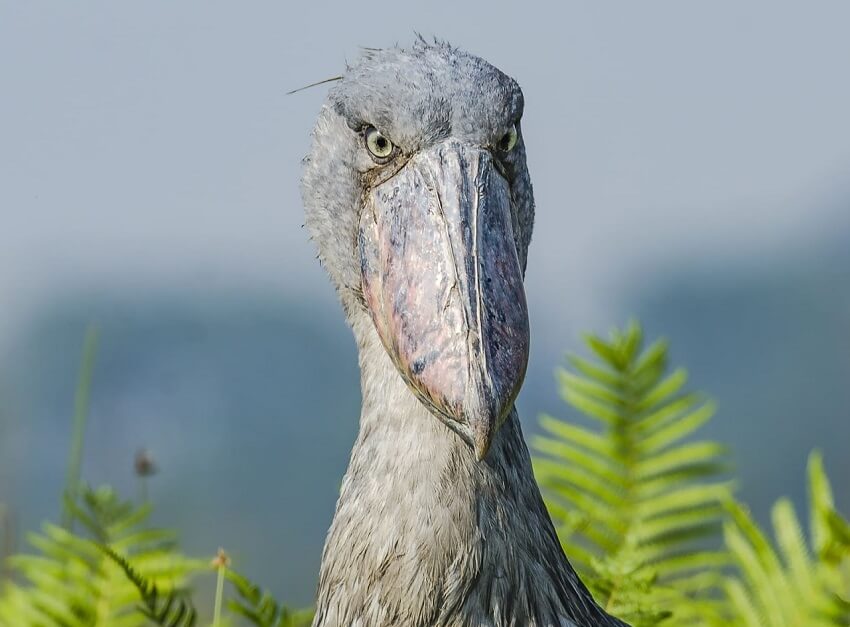
Young crocodiles, unaware of the dangers of the wild, play happily in the water, not realizing they are in the sights of a large, sharp-beaked bird. When the mother crocodile is away, the shoebill dives its head into the water, and when it lifts its head, there’s a small crocodile in its beak. The action happens in a flash, and the speed is so fast that it’s difficult for the human eye to keep up.
After a successful hunt, the shoebill finds a quiet place to enjoy its feast. Eating a baby crocodile is quite a challenge because they often swim in areas with a lot of water grass. With its wide, thick beak, the shoebill often scoops up the baby crocodile along with water grass and moss. It can take over ten minutes to remove all the water grass, but that’s not a problem for this patient bird.
Crocodile skin is very thick, and normal birds can’t eat it. But the shoebill is not a normal bird; it possesses an extremely powerful beak. For a shoebill, crocodile skin is just like a tough piece of fried dough—a little bit of force with its beak is all it takes to tear through it. Additionally, they also love to eat turtles, and a turtle’s hard shell is no match for their large beak and special digestive system.
Due to various reasons, the number of shoebills is not large; the total population in the wild and in zoos does not exceed 20,000, making it a critically endangered species. Because of their eccentric temperament and shy nature, shoebills often live in reclusive isolation from the world, and even local people find it difficult to locate them.
Compared to living in flocks, shoebills prefer to live solitary lives. They are typical nocturnal animals; they usually hide in reeds and sleep during the day, but they go out to forage at night. Their flying posture over the swamps is very similar to that of a pelican, which is why many people often mistake them for pelicans.
A shoebill’s nest is usually built on the ground near a swamp. They are made of branches and leaves, and the overall diameter can reach about two meters. The female lays two eggs per clutch during the breeding season, and both parents take turns incubating the eggs. The hatchlings can emerge from their shells after about a month and a half.
Under normal circumstances, there is a clear size difference between the two chicks, and they do not get along. The larger chick will peck at the smaller one until it is bruised and may even chase it out of the nest. Meanwhile, when the parents return from foraging, they will feed the healthier and larger chick more.
When the weather is hot, they will use their broad wings to shield the healthier chick from the intense sun. Sometimes they will use their massive beaks to scoop up water and cool down the larger chick, but the smaller chick is not treated this way; it is often abandoned by its parents, sometimes left to starve or directly exposed to the sun until it dies.
Although this method seems cruel, it is actually a survival strategy, and it is very common in the animal world. When there isn’t enough food, it ensures that at least one healthy chick will survive.
Nature has a complete biological chain. Every animal has its own survival skills. Just like the shoebill, despite its large body and inability to fly very far, it is a natural enemy of the crocodile.
However, the biggest natural enemy of animals is humans. We are partly responsible for the sharp decline in the shoebill population. Therefore, people should protect animals and live in harmony with nature. In recent years, we have all surely felt Mother Nature’s anger. We must act now before the Earth is beyond saving.
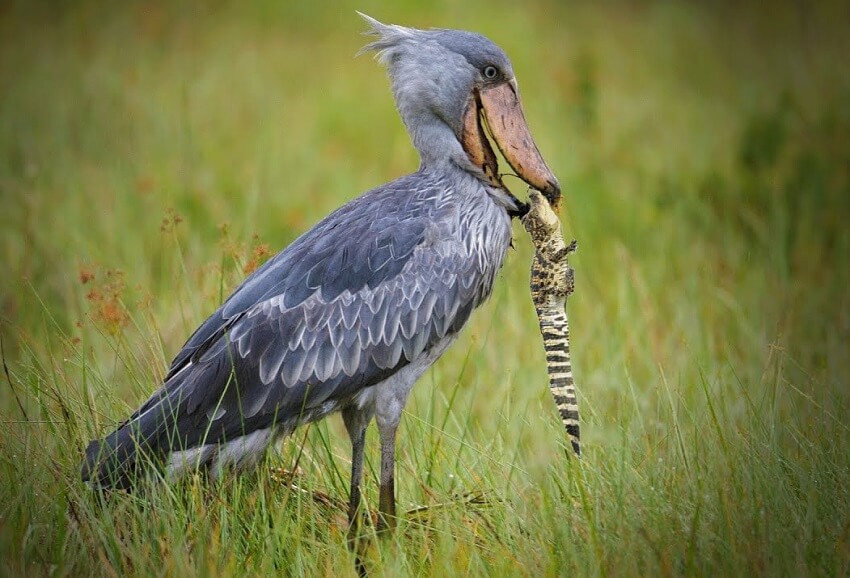
3. FAQs
1. Where do shoebills live and what is their habitat like?
This species primarily lives in the swamps of Africa, where the water is shallow and the vegetation is dense. They often stand motionless in the water for long periods to hunt their prey.
2. What do shoebills eat, and do they really hunt baby crocodiles?
Yes, they do. Their main diet consists of fish, frogs, and reptiles. They are known to hunt and eat baby crocodiles when the opportunity arises.
3. What makes the shoebill “ferocious” or frightening to observers?
Its gigantic hooked beak with razor-sharp edges, along with the immense power of its jaws, helps it slice through its prey’s flesh. This, combined with its large body size, ability to stand motionless while waiting for prey, and patient nature, makes it a dangerous natural predator of baby crocodiles.
4. Conclusion
The shoebill is not just a bird with an unusual appearance; it also possesses incredible hunting abilities, especially when confronting powerful creatures like baby crocodiles. The combination of its distinctive beak, patience, and focus has turned it into the Most Dangerous Bird in the World in its swamp ecosystem. Understanding this species not only enriches our knowledge of animals but also reminds us of our responsibility to conserve unique species like the shoebill before they face extinction.

